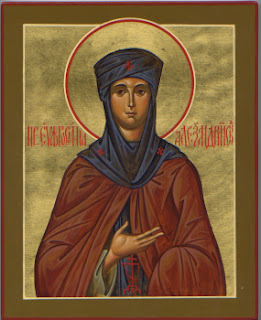The Monk Romanus the Melodist was born in the fifth century in the Syrian city of Emessa.
Having moved on to Constantinople, he became a church attendant in the temple of Saint Sophia. The monk spent his nights alone at prayer in a field or in the Blachernae church out beyond the city.
Saint Romanus did not initially have the talent for reading and song. One time, on the eve of the Nativity of Christ, he read the kathisma verses, but so poorly that another reader had to take his place, and the clergy made fun of Romanus.
The youth for a long while in grief prayed before an icon of the Most Holy Mother of God. The Mother of God appeared at night in a dream-vision to the saint, and having given him a scroll (in Greek "kondakion"), commanded him to eat it. Thus did the Monk Romanus receive the gift of book understanding, composition, and the making of churchly song. This was on the day of the Nativity of Christ. For the all-night vigil Saint Romanus in a wondrous voice sang forth in church his first kondak: "Today the Virgin giveth birth to the Transcendent One..."
From this scroll ("kondakion") all the songs of the monk became known as kondakions or kondaks. Saint Romanus was also the first to write in the form of the "ikos," a song form which he incorporated into the all-night vigil at his places of domicile (in Greek "oikos").
For his zealous service Saint Romanus was ordained to the dignity of deacon and became a teacher of song. Up until his death, which occurred in about the year 556, the Monk-Deacon Romanus the Melodist composed nearly a thousand church songs, many of which Christians still use to glorify the Lord.






















